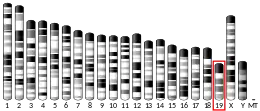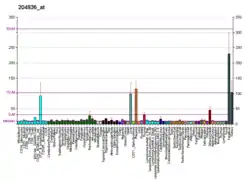Glycine dehydrogenase (decarboxylating)
Glycine decarboxylase also known as glycine cleavage system P protein or glycine dehydrogenase is an enzyme that in humans is encoded by the GLDC gene.[5][6][7]
| GLDC | |||||||||||||||||||||||||||||||||||||||||||||||||||
|---|---|---|---|---|---|---|---|---|---|---|---|---|---|---|---|---|---|---|---|---|---|---|---|---|---|---|---|---|---|---|---|---|---|---|---|---|---|---|---|---|---|---|---|---|---|---|---|---|---|---|---|
| Identifiers | |||||||||||||||||||||||||||||||||||||||||||||||||||
| Aliases | GLDC, GCE, GCSP, HYGN1, Glycine dehydrogenase, glycine decarboxylase | ||||||||||||||||||||||||||||||||||||||||||||||||||
| External IDs | OMIM: 238300 MGI: 1341155 HomoloGene: 141 GeneCards: GLDC | ||||||||||||||||||||||||||||||||||||||||||||||||||
| |||||||||||||||||||||||||||||||||||||||||||||||||||
| |||||||||||||||||||||||||||||||||||||||||||||||||||
| |||||||||||||||||||||||||||||||||||||||||||||||||||
| |||||||||||||||||||||||||||||||||||||||||||||||||||
| |||||||||||||||||||||||||||||||||||||||||||||||||||
| Wikidata | |||||||||||||||||||||||||||||||||||||||||||||||||||
| |||||||||||||||||||||||||||||||||||||||||||||||||||
| glycine decarboxylase | |||||||||
|---|---|---|---|---|---|---|---|---|---|
| Identifiers | |||||||||
| EC no. | 1.4.4.2 | ||||||||
| CAS no. | 37259-67-9 | ||||||||
| Databases | |||||||||
| IntEnz | IntEnz view | ||||||||
| BRENDA | BRENDA entry | ||||||||
| ExPASy | NiceZyme view | ||||||||
| KEGG | KEGG entry | ||||||||
| MetaCyc | metabolic pathway | ||||||||
| PRIAM | profile | ||||||||
| PDB structures | RCSB PDB PDBe PDBsum | ||||||||
| Gene Ontology | AmiGO / QuickGO | ||||||||
| |||||||||
Reaction
Glycine decarboxylase (EC 1.4.4.2) is an enzyme that catalyzes the following chemical reaction:
- glycine + H-protein-lipoyllysine H-protein-S-aminomethyldihydrolipoyllysine + CO2
Thus, the two substrates of this enzyme are glycine and H-protein-lipoyllysine, whereas its two products are H-protein-S-aminomethyldihydrolipoyllysine and CO2.[8]
This enzyme belongs to the family of oxidoreductases, specifically those acting on the CH-NH2 group of donors with a disulfide as acceptor. This enzyme participates in glycine, serine and threonine metabolism. It employs one cofactor, pyridoxal phosphate.
Function
Glycine decarboxylase is the P-protein of the glycine cleavage system in eukaryotes. The glycine cleavage system catalyzes the degradation of glycine. The P protein binds the alpha-amino group of glycine through its pyridoxal phosphate cofactor. Carbon dioxide is released and the remaining methylamine moiety is then transferred to the lipoamide cofactor of the H protein.
Degradation of glycine is brought about by the glycine cleavage system, which is composed of four mitochondrial protein components: P protein (a pyridoxal phosphate-dependent glycine decarboxylase), H protein (a lipoic acid-containing protein), T protein (a tetrahydrofolate-requiring enzyme), and L protein (a lipoamide dehydrogenase).[7]
Clinical significance
Glycine encephalopathy is due to defects in GLDC or AMT of the glycine cleavage system.[7]
References
- GRCh38: Ensembl release 89: ENSG00000178445 - Ensembl, May 2017
- GRCm38: Ensembl release 89: ENSMUSG00000024827 - Ensembl, May 2017
- "Human PubMed Reference:". National Center for Biotechnology Information, U.S. National Library of Medicine.
- "Mouse PubMed Reference:". National Center for Biotechnology Information, U.S. National Library of Medicine.
- Kume A, Koyata H, Sakakibara T, Ishiguro Y, Kure S, Hiraga K (Mar 1991). "The glycine cleavage system. Molecular cloning of the chicken and human glycine decarboxylase cDNAs and some characteristics involved in the deduced protein structures". J Biol Chem. 266 (5): 3323–9. doi:10.1016/S0021-9258(18)49991-7. PMID 1993704.
- Kure S, Narisawa K, Tada K (Mar 1991). "Structural and expression analyses of normal and mutant mRNA encoding glycine decarboxylase: three-base deletion in mRNA causes nonketotic hyperglycinemia". Biochem Biophys Res Commun. 174 (3): 1176–82. doi:10.1016/0006-291X(91)91545-N. PMID 1996985.
- "Entrez Gene: GLDC glycine dehydrogenase (decarboxylating)".
- Kikuchi G (2008). "The glycine cleavage system: reaction mechanism, physiological significance, and hyperglycinemia". Proc. Jpn. Acad. Ser. B Phys. Biol. Sci. 84 (7): 246–63. Bibcode:2008PJAB...84..246K. doi:10.2183/pjab.84.246. PMC 3666648. PMID 18941301.
Further reading
- Hiraga K, Kikuchi G (1980). "The mitochondrial glycine cleavage system. Functional association of glycine decarboxylase and aminomethyl carrier protein". J. Biol. Chem. 255 (24): 11671–6. doi:10.1016/S0021-9258(19)70184-7. PMID 7440563.
- Perham RN (2000). "Swinging arms and swinging domains in multifunctional enzymes: catalytic machines for multistep reactions". Annu. Rev. Biochem. 69: 961–1004. doi:10.1146/annurev.biochem.69.1.961. PMID 10966480.
- Broadwater JA, Haas JA, Fox BG, Booker SJ (2005). "Expression, purification, and physical characterization of Escherichia coli lipoyl(octanoyl)transferase". Protein Expr. Purif. 39 (2): 269–82. doi:10.1016/j.pep.2004.10.021. PMID 15642479.*Applegarth DA, Toone JR (2001). "Nonketotic hyperglycinemia (glycine encephalopathy): laboratory diagnosis". Mol. Genet. Metab. 74 (1–2): 139–46. doi:10.1006/mgme.2001.3224. PMID 11592811.
- Kure S, Takayanagi M, Narisawa K, et al. (1992). "Identification of a common mutation in Finnish patients with nonketotic hyperglycinemia". J. Clin. Invest. 90 (1): 160–4. doi:10.1172/JCI115831. PMC 443076. PMID 1634607.
- Sakakibara T, Koyata H, Ishiguro Y, et al. (1991). "One of the two genomic copies of the glycine decarboxylase cDNA has been deleted at a 5' region in a patient with nonketotic hyperglycinemia". Biochem. Biophys. Res. Commun. 173 (3): 801–6. doi:10.1016/S0006-291X(05)80858-7. PMID 2268343.
- Burton BK, Pettenati MJ, Block SM, et al. (1989). "Nonketotic hyperglycinemia in a patient with the 9p- syndrome". Am. J. Med. Genet. 32 (4): 504–5. doi:10.1002/ajmg.1320320416. PMID 2773994.
- Hayasaka K, Kochi H, Hiraga K, Kikuchi G (1981). "Purification and properties of glycine decarboxylase, a component of the glycine cleavage system, from rat liver mitochondria and immunochemical comparison of this enzyme from various sources". J. Biochem. 88 (4): 1193–9. doi:10.1093/oxfordjournals.jbchem.a133074. PMID 6778858.
- Hiraga K, Kochi H, Hayasaka K, et al. (1981). "Defective glycine cleavage system in nonketotic hyperglycinemia. Occurrence of a less active glycine decarboxylase and an abnormal aminomethyl carrier protein". J. Clin. Invest. 68 (2): 525–34. doi:10.1172/JCI110284. PMC 370827. PMID 6790577.
- Takayanagi M, Kure S, Sakata Y, et al. (2000). "Human glycine decarboxylase gene (GLDC) and its highly conserved processed pseudogene (psiGLDC): their structure and expression, and the identification of a large deletion in a family with nonketotic hyperglycinemia". Hum. Genet. 106 (3): 298–305. doi:10.1007/s004390051041. PMID 10798358.
- Toone JR, Applegarth DA, Coulter-Mackie MB, James ER (2000). "Biochemical and molecular investigations of patients with nonketotic hyperglycinemia". Mol. Genet. Metab. 70 (2): 116–21. doi:10.1006/mgme.2000.3000. PMID 10873393.
- Toone JR, Applegarth DA, Coulter-Mackie MB, James ER (2001). "Recurrent mutations in P- and T-proteins of the glycine cleavage complex and a novel T-protein mutation (N145I): a strategy for the molecular investigation of patients with nonketotic hyperglycinemia (NKH)". Mol. Genet. Metab. 72 (4): 322–5. doi:10.1006/mgme.2001.3158. PMID 11286506.
- Kure S, Kojima K, Ichinohe A, et al. (2002). "Heterozygous GLDC and GCSH gene mutations in transient neonatal hyperglycinemia". Ann. Neurol. 52 (5): 643–6. doi:10.1002/ana.10367. PMID 12402263. S2CID 7553866.
- Strausberg RL, Feingold EA, Grouse LH, et al. (2003). "Generation and initial analysis of more than 15,000 full-length human and mouse cDNA sequences". Proc. Natl. Acad. Sci. U.S.A. 99 (26): 16899–903. doi:10.1073/pnas.242603899. PMC 139241. PMID 12477932.
- Toone JR, Applegarth DA, Laliberte G (2003). "Gene Symbol: GLDC. Disease: NKH glycine encephalopathy". Hum. Genet. 113 (5): 465. doi:10.1007/s00439-003-1014-5. PMID 14552331.
- Dinopoulos A, Kure S, Chuck G, et al. (2006). "Glycine decarboxylase mutations: a distinctive phenotype of nonketotic hyperglycinemia in adults". Neurology. 64 (7): 1255–7. doi:10.1212/01.WNL.0000156800.23776.40. PMID 15824356. S2CID 38972294.
- Flusser H, Korman SH, Sato K, et al. (2006). "Mild glycine encephalopathy (NKH) in a large kindred due to a silent exonic GLDC splice mutation". Neurology. 64 (8): 1426–30. doi:10.1212/01.WNL.0000158475.12907.D6. PMID 15851735. S2CID 6661158.
- Boneh A, Korman SH, Sato K, et al. (2005). "A single nucleotide substitution that abolishes the initiator methionine codon of the GLDC gene is prevalent among patients with glycine encephalopathy in Jerusalem". J. Hum. Genet. 50 (5): 230–4. doi:10.1007/s10038-005-0243-y. PMID 15864413.
- Kimura K, Wakamatsu A, Suzuki Y, et al. (2006). "Diversification of transcriptional modulation: large-scale identification and characterization of putative alternative promoters of human genes". Genome Res. 16 (1): 55–65. doi:10.1101/gr.4039406. PMC 1356129. PMID 16344560.
- Korman SH, Wexler ID, Gutman A, et al. (2006). "Treatment from birth of nonketotic hyperglycinemia due to a novel GLDC mutation". Ann. Neurol. 59 (2): 411–5. doi:10.1002/ana.20759. PMID 16404748. S2CID 37119917.




